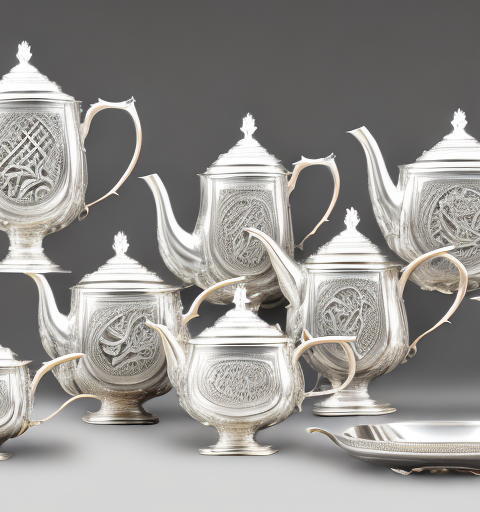Understanding Induction Cooktops: An Overview
Induction cooktops have gained popularity in recent years due to their fast and efficient cooking capabilities. Unlike traditional gas or electric stovetops, induction cooktops use electromagnetism to directly heat the cookware, rather than heating the surface beneath it.
When it comes to using a ceramic teapot on an induction cooktop, there are several factors to consider. In this article, we will explore the science behind induction cooktops and ceramic teapots, the compatibility between the two, and provide you with a step-by-step guide on how to safely use a ceramic teapot on an induction cooktop. We will also address common concerns, myths, and alternative options for brewing tea on an induction cooktop.
One of the key factors to consider when using a ceramic teapot on an induction cooktop is the material of the teapot itself. Ceramic teapots are generally compatible with induction cooktops, as long as they have a magnetic base. The magnetic base allows the teapot to interact with the electromagnetic field generated by the cooktop, enabling efficient heating.
It is important to note that not all ceramic teapots are suitable for induction cooktops. Some ceramic teapots may have a non-magnetic base, which means they will not work effectively on an induction cooktop. To determine if your ceramic teapot is compatible, you can use a magnet to check if it sticks to the base of the teapot.
In addition to the material, the size and shape of the teapot can also affect its performance on an induction cooktop. Teapots with a wider base and a flat bottom tend to work better, as they provide more surface area for the electromagnetic field to interact with. It is also recommended to choose a teapot with a sturdy handle that can withstand the heat generated by the induction cooktop.
When using a ceramic teapot on an induction cooktop, it is important to follow the manufacturer’s instructions and safety guidelines. Avoid placing an empty teapot on the cooktop, as this can cause damage to both the teapot and the cooktop. Always ensure that the teapot is properly centered on the cooking zone and avoid dragging it across the surface to prevent scratches.
Overall, with the right ceramic teapot and proper usage, you can enjoy a delightful cup of tea using an induction cooktop. However, if you prefer alternative options, there are also induction-compatible teakettles and electric tea makers available in the market that offer convenience and efficiency.
The Science Behind Induction Cooktops and Ceramic Teapots
Before delving into the compatibility between ceramic teapots and induction cooktops, let’s first understand the science behind induction cooktops. These innovative appliances generate an electromagnetic field that causes the molecules within the metal cookware to vibrate rapidly, creating heat. As a result, the cookware itself becomes the heat source while the cooktop remains cool to the touch.
Ceramic teapots, on the other hand, are typically made from clay or porcelain and are known for their excellent heat retention properties. The material used in the construction of ceramic teapots is not inherently magnetic, making it less responsive to induction cooktops. However, there are certain types of ceramic teapots that are designed with a ferromagnetic material in the base, allowing them to work efficiently on induction cooktops.
Induction cooktops offer several advantages over traditional gas or electric stovetops. Firstly, they provide precise temperature control, allowing for more accurate cooking. Additionally, induction cooktops heat up much faster than other types of cooktops, reducing cooking time. They are also more energy-efficient, as they only heat the cookware and not the surrounding air, resulting in less wasted heat. Furthermore, induction cooktops are easier to clean, as spills and splatters do not burn onto the surface since it does not get hot. Overall, induction cooktops are a modern and efficient option for cooking.
Exploring the Compatibility between Ceramic Teapots and Induction Cooktops
When considering whether your ceramic teapot is compatible with an induction cooktop, it’s essential to determine whether the base of your teapot contains ferromagnetic material. To do this, you can use a magnet to check whether it sticks to the teapot’s base. If the magnet sticks, it indicates the presence of ferromagnetic material, and your teapot is suitable for use on an induction cooktop.
However, even if your ceramic teapot does not have a ferromagnetic base, there are still options available to make it compatible with an induction cooktop. You can use an induction disc, which is a flat, ferromagnetic plate that acts as a bridge between the cooktop’s magnetic field and your non-magnetic teapot. Simply place the induction disc on the cooktop and position your ceramic teapot on top, allowing the heat to transfer through the disc.
Another alternative to make your ceramic teapot compatible with an induction cooktop is to use an induction adapter. An induction adapter is a device that is placed between the cooktop and the teapot, allowing the transfer of heat through electromagnetic induction. The adapter is typically made of a ferromagnetic material and has a flat surface that the teapot can sit on. By using an induction adapter, you can enjoy the benefits of using an induction cooktop with your ceramic teapot, even if it does not have a ferromagnetic base.
Factors to Consider Before Using a Ceramic Teapot on an Induction Cooktop
While it’s possible to use a ceramic teapot on an induction cooktop, there are a few key factors to consider to ensure a safe and successful brewing experience. Firstly, it’s important to assess the size and weight of your teapot, as induction cooktops require magnetic contact for efficient heat transfer. If your teapot is too small or lightweight, it may not maintain a stable connection with the cooktop, leading to suboptimal heat distribution.
Additionally, it’s crucial to follow your manufacturer’s guidelines for using cookware on an induction cooktop. Some teapots may have specific temperature limits, and exceeding these limits could cause damage to the teapot or compromise the quality of your tea. Always err on the side of caution and avoid overheating your ceramic teapot.
Another factor to consider is the material of the ceramic teapot. Not all ceramic teapots are suitable for use on induction cooktops. It’s important to ensure that your teapot is specifically designed for induction cooking. Look for teapots that are labeled as “induction compatible” or “suitable for induction cooktops” to ensure that it will work effectively and safely.
Furthermore, it’s recommended to use a teapot with a flat and smooth bottom surface when using it on an induction cooktop. This allows for better contact and heat transfer between the teapot and the cooktop. Teapots with uneven or textured bottoms may not make proper magnetic contact, resulting in uneven heating and potential damage to the cooktop.
Advantages of Using Ceramic Teapots on an Induction Cooktop
Despite the potential limitations and factors to consider, using a ceramic teapot on an induction cooktop offers several advantages. The even and precise heat distribution of induction cooktops allows for optimal temperature control, which is essential for brewing delicate teas. Additionally, the heat retention properties of ceramic teapots help to keep your tea warm for longer periods, allowing you to savor each cup at your leisure.
Furthermore, ceramic teapots are often favored for their aesthetic appeal and ability to enhance the overall tea-drinking experience. The natural materials used in their construction can impart subtle flavors and aromas, adding depth and complexity to your favorite brews.
Another advantage of using ceramic teapots on an induction cooktop is their durability. Ceramic is a sturdy material that can withstand high temperatures without cracking or breaking. This means that you can use your ceramic teapot on the induction cooktop without worrying about it getting damaged.
In addition, ceramic teapots are easy to clean. Unlike some other materials, such as cast iron, ceramic does not require special cleaning methods or seasoning. You can simply wash your ceramic teapot with warm soapy water and a soft sponge, making it convenient and hassle-free to maintain.
Common Concerns and Myths about Using Ceramic Teapots on Induction Cooktops
There are various concerns and myths that surround the use of ceramic teapots on induction cooktops. One common misconception is that the intense magnetic field generated by induction cooktops can damage or crack ceramic teapots. However, the magnetic field itself poses no threat to the teapot’s structural integrity, as long as it does not exceed the maximum temperature tolerance set by the manufacturer.
Another concern is the fear of uneven heating, leading to unsatisfactory tea brewing results. While it’s true that ceramic teapots may have slight variations in heat distribution, it is more a matter of adjusting the brewing technique to account for these differences rather than a significant drawback.
How to Safely Use a Ceramic Teapot on an Induction Cooktop: Step-by-Step Guide
Now that we have addressed the science, compatibility, and concerns related to using ceramic teapots on induction cooktops, let’s delve into a step-by-step guide to safely using your teapot on an induction cooktop:
- Ensure your ceramic teapot has a ferromagnetic base or use an induction disc if not.
- Clean the teapot thoroughly, removing any dust or debris that may affect your tea’s flavor.
- Fill the teapot with the desired amount of water, respecting the maximum capacity set by the manufacturer.
- Place the teapot on the induction cooktop’s surface, ensuring it makes firm contact with the cooktop or induction disc.
- Select the appropriate temperature setting on the induction cooktop, taking into account the type of tea you are brewing.
- Allow the tea to steep for the recommended time, following the brewing guidelines specific to your tea variety.
- After steeping, carefully remove the teapot from the induction cooktop, using heat-resistant oven mitts or cloth to protect your hands.
- Pour your deliciously brewed tea into cups or a teapot warmer to enjoy at your leisure.
Alternative Options for Brewing Tea on an Induction Cooktop
If you find that your ceramic teapot is not suitable for use on an induction cooktop or prefer to explore alternative brewing methods, there are several options available:
- Opt for an induction-compatible teapot made from materials such as stainless steel or cast iron.
- Utilize an electric kettle specifically designed for use on induction cooktops.
- Experiment with single-serve tea infusers or teabags that can be directly placed in your cup or mug.
Remember, the choice of brewing method ultimately comes down to personal preference and the specific requirements of the tea variety you are preparing.
Tips for Maintaining and Cleaning a Ceramic Teapot for Induction Cooktop Use
To ensure the longevity and optimal performance of your ceramic teapot when used on an induction cooktop, it’s important to follow these maintenance and cleaning tips:
- Always handle your teapot with care to avoid accidental damage or injury.
- After each use, allow the teapot to cool naturally before cleaning.
- Wash the teapot by hand, using mild dish soap and a soft sponge or cloth.
- Avoid using abrasive cleaning tools or harsh chemicals that may scratch or damage the teapot’s surface.
- Rinse the teapot thoroughly to remove any soap residue.
- Dry the teapot completely before storing to prevent mold or mildew growth.
By following these simple maintenance and cleaning practices, you can enjoy your ceramic teapot on an induction cooktop for many delightful tea sessions to come.
Expert Recommendations: Best Practices for Using a Ceramic Teapot on an Induction Cooktop
While we have covered many aspects of using a ceramic teapot on an induction cooktop, it’s always valuable to consider expert recommendations to enhance your tea brewing experience. Here are a few best practices to keep in mind:
- Preheat your teapot before adding the water. This helps to maintain a consistent brewing temperature.
- Use filtered water to reduce mineral build-up on your teapot’s surface.
- Avoid using a teapot with intricate designs or glazes that may be sensitive to temperature changes.
- Consider investing in a tea thermometer to ensure precise temperature control, especially for teas that require specific water temperatures.
- Experiment with different brewing times, water-to-tea ratios, and water temperatures to personalize your brewing technique.
By incorporating these expert recommendations, you can elevate your ceramic teapot brewing experience on an induction cooktop to new heights.
Exploring Other Types of Teapots Suitable for Induction Cooktops
If you are looking to expand your teapot collection or prefer options other than ceramic, there are several alternative materials that are compatible with induction cooktops:
- Stainless Steel Teapots: Known for their durability and excellent heat conductivity, stainless steel teapots are a popular choice for induction cooktops.
- Cast Iron Teapots: Appreciated for their heat retention properties, cast iron teapots distribute heat evenly, resulting in a more flavorful tea.
- Glass Teapots: Transparent and elegant, glass teapots allow you to witness the brewing process and are compatible with induction cooktops.
Exploring these different teapot options can provide a delightful variety in brewing experiences and cater to your preferred tea brewing style.
Troubleshooting Guide: What to Do if Your Ceramic Teapot Doesn’t Work on an Induction Cooktop
If you find that your ceramic teapot is not working efficiently on an induction cooktop, there are a few troubleshooting steps you can take:
- Make sure the teapot’s base is clean and free from any debris that may disrupt the magnetic connection.
- Check if the induction cooktop is functioning correctly by testing it with other induction-compatible cookware.
- Ensure that the teapot is placed securely on the induction cooktop or induction disc for optimal magnetic contact.
- Consider using an alternative brewing method, such as an induction-compatible teapot or electric kettle.
- Consult your teapot’s manufacturer or an appliance specialist for further advice if the issue persists.
Remember, finding the right combination of cookware and cooktop compatibility may require some experimentation and adjustment.
Case Studies: Real-Life Experiences of Using Ceramic Teapots on Induction Cooktops
To gain insight into the practical experiences of individuals using ceramic teapots on induction cooktops, we compiled real-life case studies. These anecdotes provide firsthand accounts of tea enthusiasts who have successfully brewed tea using ceramic teapots on induction cooktops.
Case Study 1: Karen’s Induction Teapot Adventure
Karen, an avid tea lover, was initially uncertain about using her cherished ceramic teapot on her new induction cooktop. However, after discovering the presence of a ferromagnetic base, she eagerly gave it a try. Karen was delighted to find that her teapot brewed tea flawlessly on the induction cooktop, offering the same flavorful infusion she had grown fond of.
Case Study 2: Michael’s Induction Disc Solution
Michael, a tea connoisseur, owned a beautiful ceramic teapot that lacked the necessary magnetic properties for use on his induction cooktop. Instead of resorting to alternative teapots, he opted for an induction disc. By using the disc, Michael was able to enjoy steaming hot tea brewed to perfection, all the while preserving the aesthetic appeal of his beloved ceramic teapot.
These case studies exemplify the versatility and adaptability of ceramic teapots when it comes to induction cooktops, highlighting that with the right techniques and accessories, a delightful tea brewing experience can be achieved.
Conclusion
In conclusion, the compatibility between ceramic teapots and induction cooktops relies on the presence of ferromagnetic material in the teapot’s base or the use of an induction disc. By following the recommended steps, guidelines, and expert advice provided in this article, you can safely and efficiently use your ceramic teapot on an induction cooktop.
Whether you choose to explore alternative teapot materials, troubleshoot issues, or gain inspiration from real-life experiences, remember that the art of brewing tea goes beyond the choice of cookware. Embrace the simplicity, elegance, and ritual of tea brewing, and let your ceramic teapot become a cherished companion on your tea-drinking journey.






